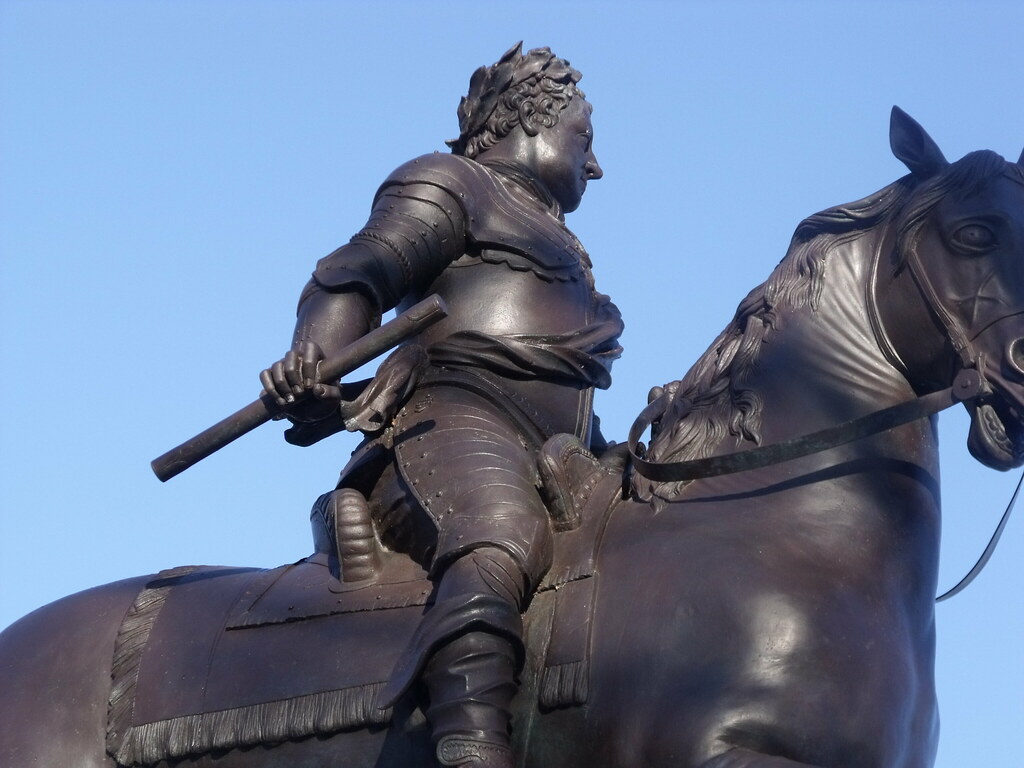Miniature Lead, Equestrian Statue of George II.
by John van Nost III.
Dublin Castle.
Photographs - second series.
The miniature of the Bronze, Equestrian statue set up on St Stephens Green, Dublin in 1758.
Photographs by the Author taken 5 October 2016.
Once again I am indebted to The Irish Aesthete, and William Derham and Joanne Bannon of Dublin Castle.
In Protestant Dublin 1660 - 1760 Architecture and Iconography - by Robin Usher he mentions a miniature equestrian statue of the St Stephens Green George II which was given to the (Royal) Dublin Society by Patrick Cunningham the pupil of van Nost from 1750, noted by John Turpin School of Art in Dublin ..... but it is not yet clear to me whether the statuette was by van Nost or Cunningham.
This statuette is no longer with the RDS which begs the question "is this the missing statuette?"
The National Portrait Gallery website describes an Equestrian statuette of George II by van Nost owned by the late Sir James Mann as a miniature version of the statue on St Stephens Green. It was exhibited in an Exhibition entitled Kings and Queens at the Royal Academy in 1953.
It seems unlikely tho' not impossible that this is the one belonging to Sir James Mann.
Peter Hone remembers the statuette illustrated here being found at an Antique fair in Ireland.
High resolution images right click to open.
Equestrian Portrait of George II by Joseph Highmore
This portrait is so similar to the statuette by van Nost that it cannot be a coincidence.
I leave the viewer to make up their own mind which came first.

The Van Nost II equestrian statue of George I originally on the the Essex Bridge, Dublin.
This statue spent a considerable tine in the workshop of John van Nost III at Aungier Street, Dublin before being set up in the grounds of the mansion house in Dublin in 1797.
One has to say that the detail is so close in these two statues nb the saddle and saddle cloth and the armour that van Nost III must basically have taken a cast from the original of George I and made a copy of this statue whilst it was in his yard, changing a few details and replacing the head.
For a reasonably detailed of this statue and its history analysis see my post -

An Equestrian portrait of George II
Joseph Highmore 1692 - 1780.
they say c 1743 - 5.
750 x 630 cms.
Presented to the Tate in 1988 by the Patrons of British Art through the Friends of the Tate Gallery.
Tate Gallery London
This text lifted from the Tate Website
Although highly finished, Highmore may nevertheless have painted this small equestrian portrait of George II (1683-1760) as a preliminary design for a life-size portrait that remained unexecuted. The composition is clearly influenced by the celebrated life-size equestrian portrait of Charles I (1600-49) painted by Sir Anthony van Dyck (1599-1641) in 1633 (London, National Gallery), which was in turn based upon the 1548 portrait of the emperor Charles V by Titian (c.1488-1576) (Prado, Madrid).
Given the grandeur of Highmore's composition and its precedents, it has been suggested (Tate 1996, p.37) that the present portrait may have been planned as a pendant to Van Dyck's portrait, or to one of the numerous copies taken from it.
As in Van Dyck's portrait of Charles I, George II is dressed in full armour and mounted upon a charger. He emerges from beneath a classical triumphal arch, a device also used by Van Dyck in another equestrian portrait of Charles I (Royal Collection Trust). Behind him is a pageboy carrying his plumed helmet. In the distance, to the right, can be discerned a cavalry troop.
While the picture alludes generally to the King's prowess as a military leader, it may also have had a specific reference to the battle of Dettingen of 1743, in which George II had personally led British and Hanoverian troops to victory against the French. It was, moreover, a victory that had greatly boosted his popularity among his British subjects, who were otherwise suspicious of his strong adherence to his German roots. Indeed, George had been criticised for wearing Hanoverian colours at the battle. Here he wears a fanciful suit of 'antique' armour.
The picture was probably commissioned by Cosmo, 3rd Duke of Gordon (c.1721-52), to whom it belonged by about 1764, when it hung at Gordon Castle, Banff, Scotland. The Duke of Gordon was an ardent supporter of George II and played a prominent role in quelling the Jacobite rebellion in 1745, for which he was made a Knight of the Thistle in 1748. It has been suggested (Tate 1996, p.37) that the Duke of Gordon may have commissioned this picture either as a christening present for his son, Alexander, later 4th Duke of Gordon (1743-1827) or his youngest son, George (1751-93), whose baptismal sponsor was the King.

Mezzotint by J Tinney of the Golden Lion Fleet Street
of the original by Highmore
353 x 252 mm











No comments:
Post a Comment